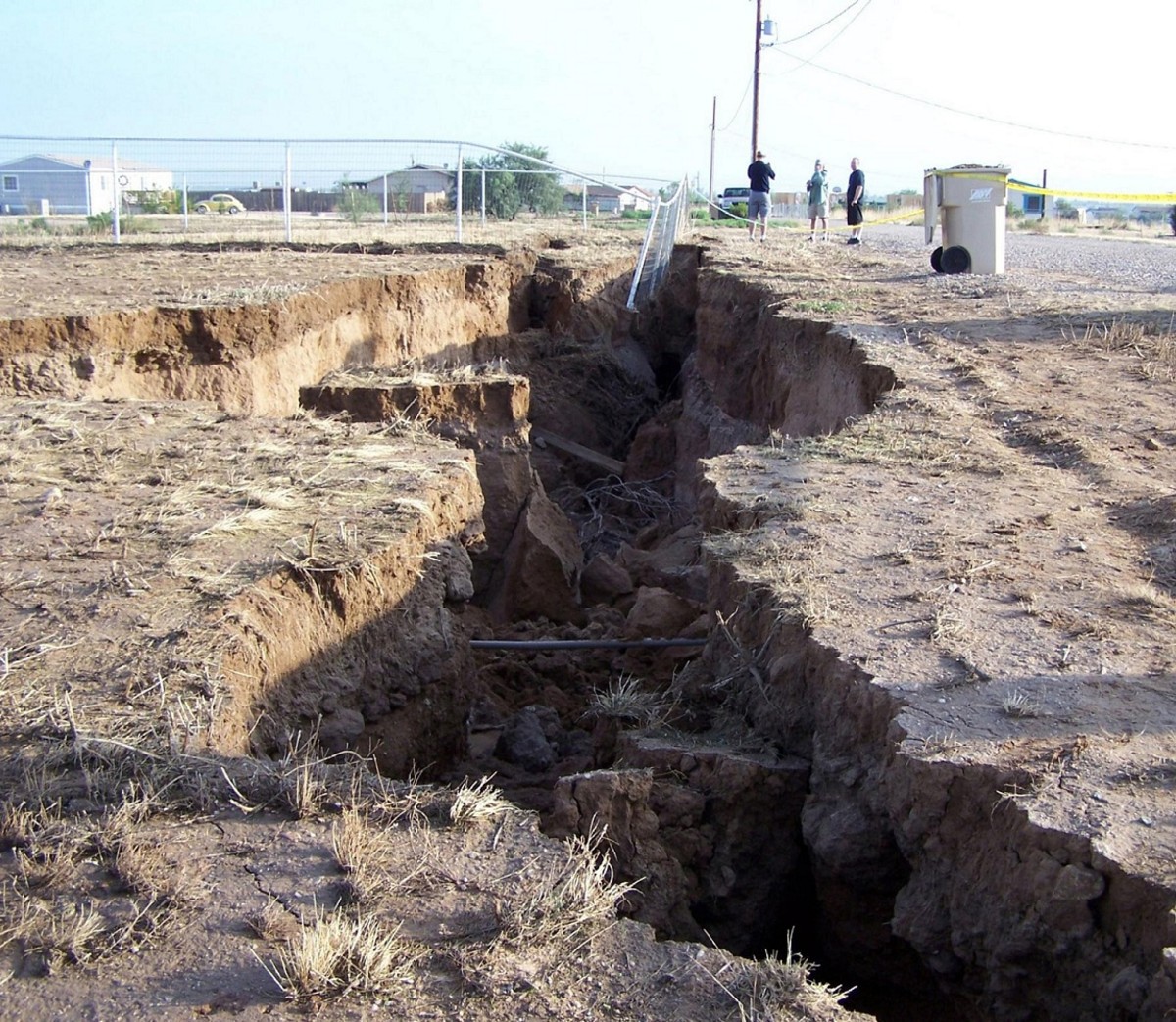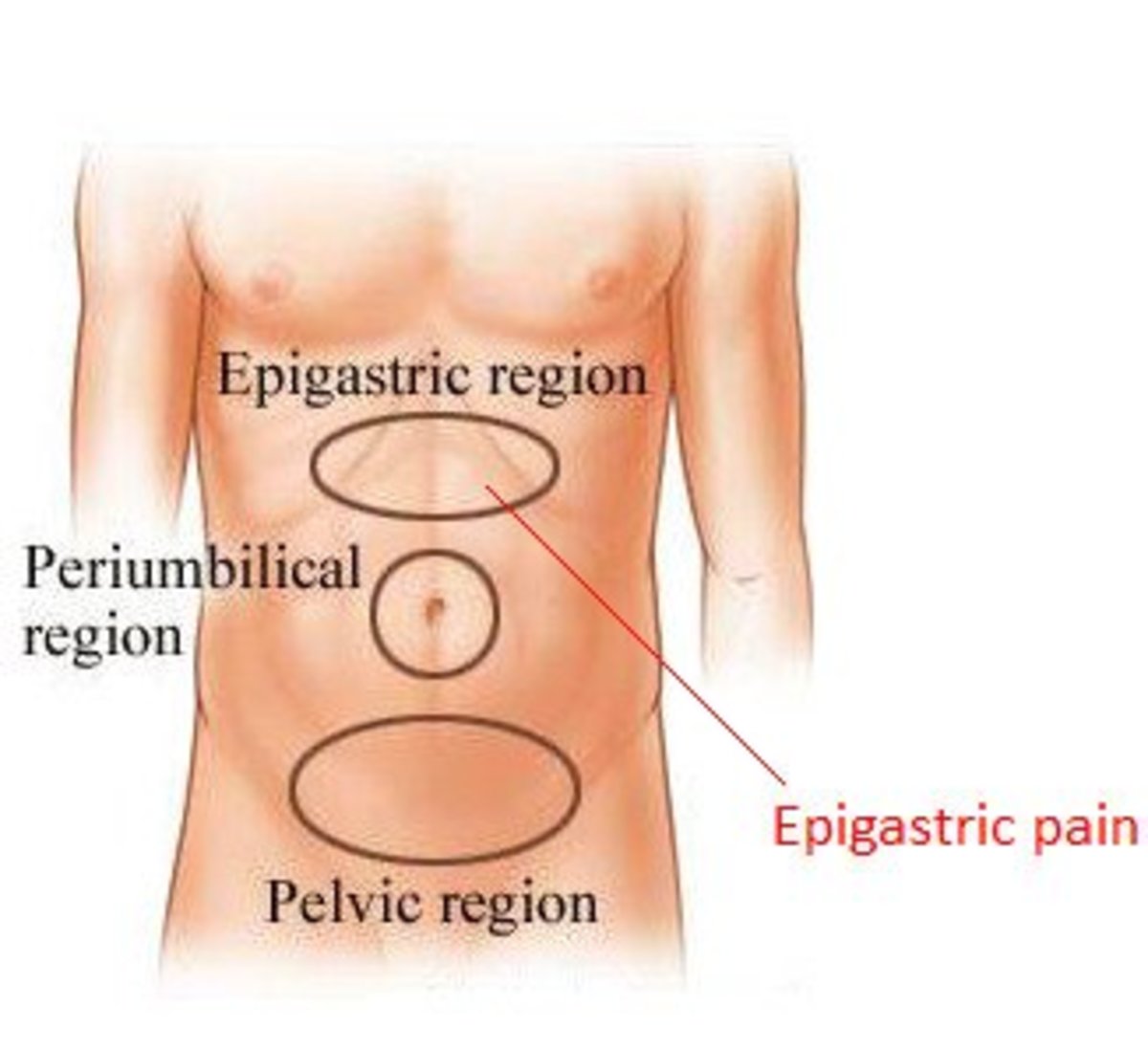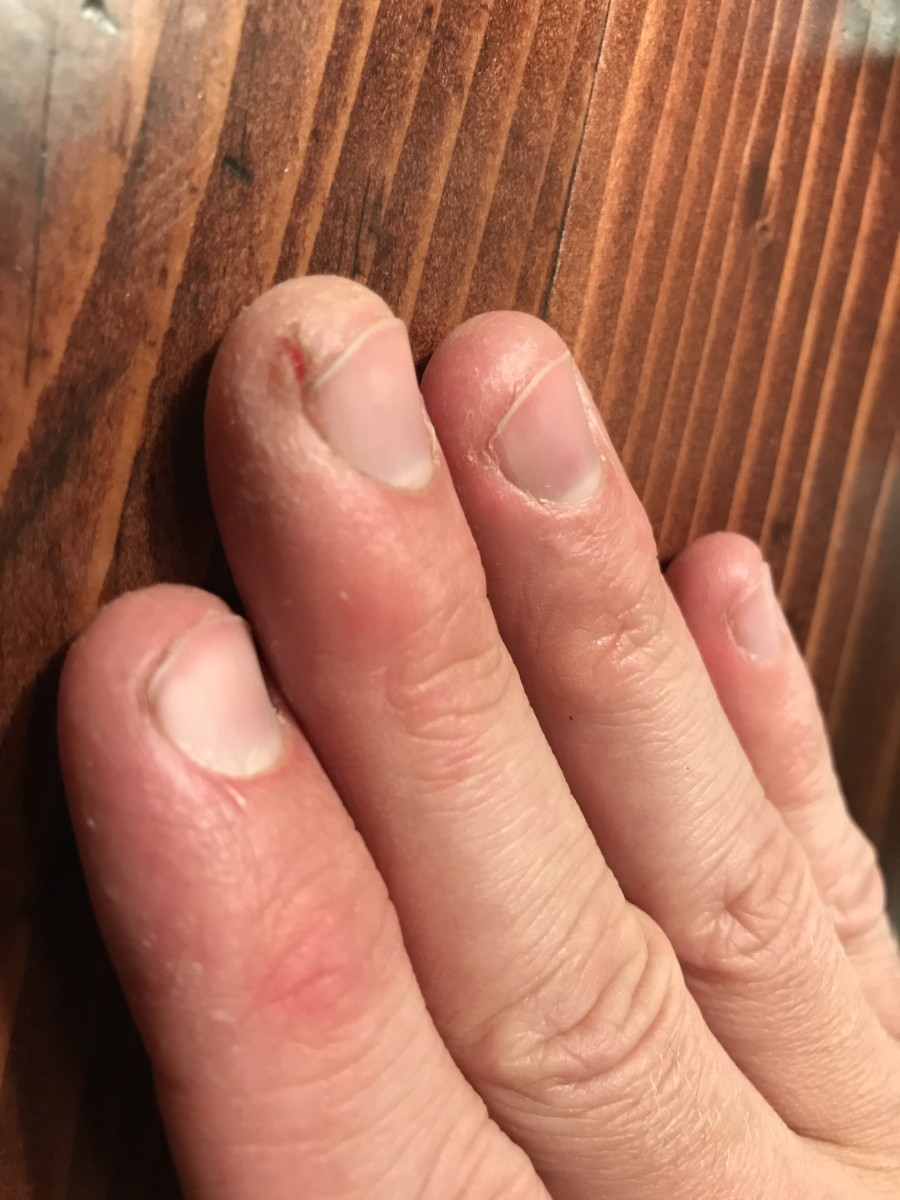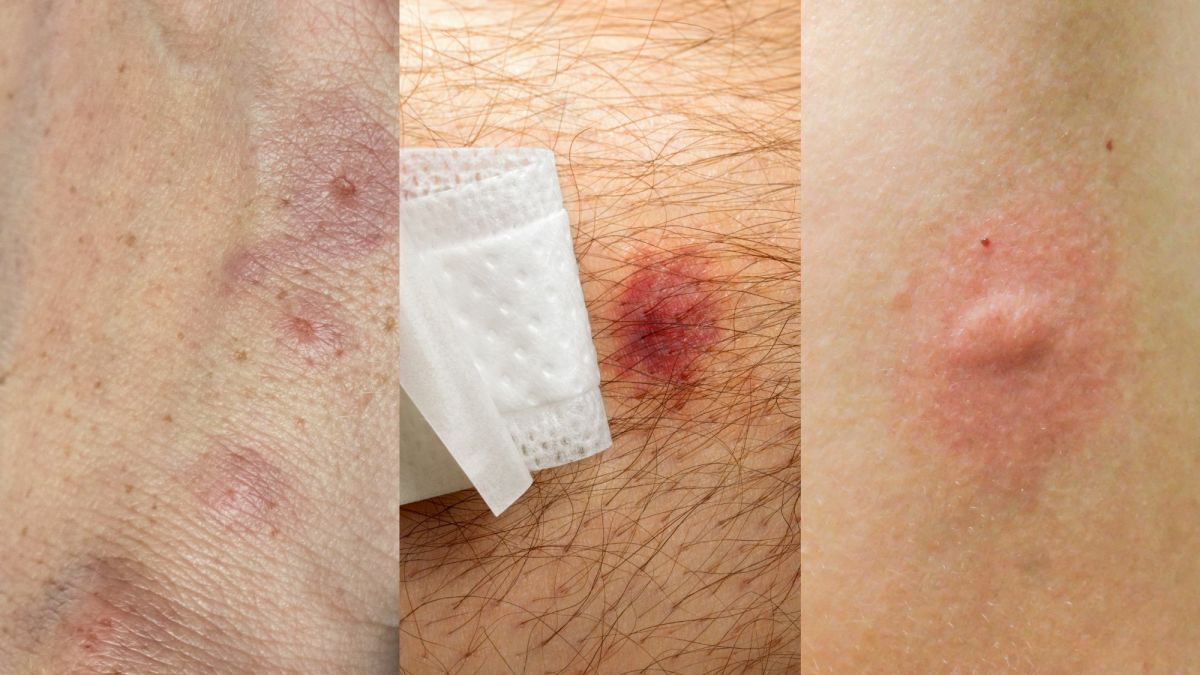Anal Fissure
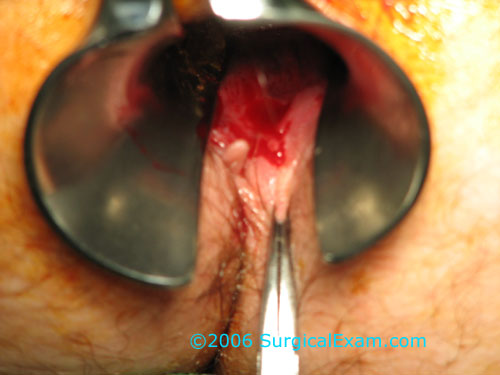
A fissure-in-ano is a painful linear ulcer situated in the anal canal. It is a very common condition that causes suffering out of proportion to the size of the lesion. In the acute phase, the lesion is often a mere crack in the epithelial surface but may cause much pain and spasm. The lesion is usually encountered in younger and middleaged adults but also may occur in infants, children, and the elderly. Fissures are equally common in both sexes. Most of the fissures are located in posterior midline. The initiating factor in the development of a fissure is trauma to the anal canal, usually in the form of the passage of a fecal bolus that is large and hard. Secondary fissures may occur as a result of either an anatomic anal abnormality or inflammatory bowel disease, particularly Crohn’s disease. The association of Crohn’s disease with anal fissures is well recognized. Previous anal surgery, especially hemorrhoidectomy, may result in anal scarring, skin loss, and stenosis. Fistula-in-ano surgery may result in distortion of the anal canal with scarring and fixation of the anal skin. This decreased elasticity of the anal canal may then predispose to fissure formation. Some of the anterior fissures occurring in women result from childbirth. Perineal trauma leads to scarring and abnormal tethering of the anal submucosa, thus rendering it more susceptible to trauma because of its loss of laxity and mobility. Individuals with a long-standing condition of loose stools, usually resulting from chronic laxative abuse, may develop an anal stenosis with scarring, again predisposing to fissure formation. The presence of hemorrhoids is not likely a predisposing factor; more likely an abnormality of the internal sphincter predisposes the patient to the formation of both hemorrhoids and fissures. Persistently hard bowel movements, in addition to initiating the process, may continuously aggravate the anal canal and result in perpetuation of the fissure. This factor must be taken into account when planning treatment. After the initiation of a tear in the anal canal, chronicity is perpetuated by an abnormality in the internal anal sphincter.
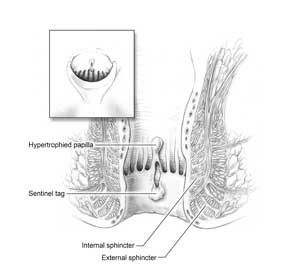
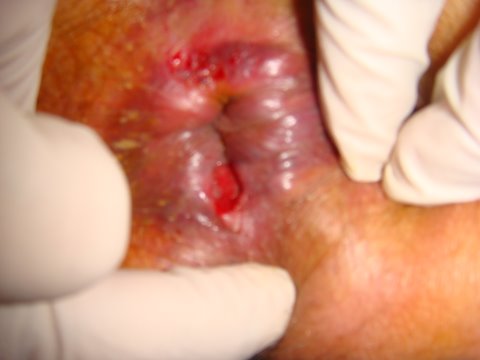
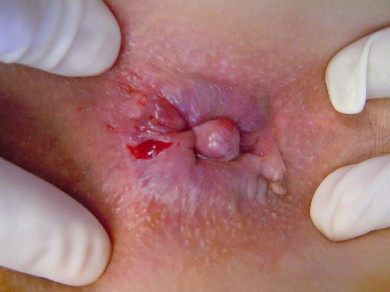
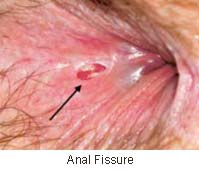
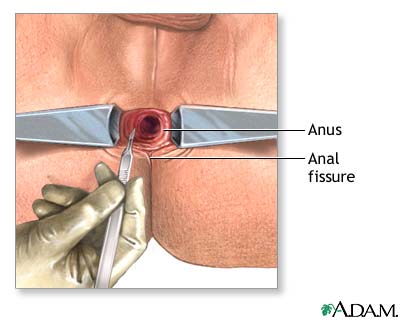
SYMPTOMS
The cardinal symptom of an anal fissure is pain in the anus during and after defecation. The pain usually is described as a sharp, cutting, or tearing sensation during the actual passage of stool. Subsequently, the pain may be less severe and may be described as a burning or gnawing discomfort that may persist from a few minutes to several hours. Because of the anticipated pain, the patient may not defecate when the natural urge occurs. Such procrastination leads to harder stools, with subsequent bowel movements more painful. A relentless cycle may ensue with the individual living from one bowel movement to the next.
Bleeding is very common with fissure-in-ano but is not invariably present. The blood is bright red and usually scant in amount.
Some patients have a large sentinel pile that draws their attention to the anus. In such circumstances, patients usually complain of a painful external hemorrhoid.
Discharge may lead to soiling of the underclothes and to increased moisture on the perianal skin, with resulting pruritus ani, although pruritus may occur independently of any discharge.
Constipation is frequently touted as an accompanying symptom as well as an initiating symptom of anal fissure. Sometimes patients with a painful fissure develop disturbances of micturition, namely dysuria, retention, or frequency. Although not usually a presenting complaint, painful coitus may be caused by an anal fissure.
DIAGNOSIS
The diagnosis of a fissure is usually straightforward and is made from the patient’s history alone. A physical examination confirms the suspicion of fissure and rules out other associated disease. The association between fissures and inflammatory bowel disease should always be remembered, and a careful history should be taken and followed, if indicated, by appropriate radiologic, hematologic, and biochemical investigations. Inspection is by far the most important step in the examination for anal fissure. If properly sought, most fissures can be seen. Because anal fissures are such extremely painful lesions, special care must be taken to make the examination as gentle as possible. Gentle separation of the buttocks usually reveals the fissure; however, spasm may keep the anal orifice closed, and the finding of spasm of a sphincter is suggestive of a fissure. The coexistence of large hemorrhoids or skin folds may hide the ulcer. Nonvisualization of the lesion does not rule out its presence, and the diagnosis may be made more by history and palpation than by visual appearance. The triad of a chronic fissure includes a sentinel pile, an anal ulcer, and a hypertrophied anal papilla, with the sentinel pile noted first posteriorly.
Palpation is the next step in the examination and confirms the presence of sphincter spasm. The digital examination is uncomfortable, with maximal tenderness usually elicited in the posterior midline. In fact, the pain may be so intense that a complete digital examination cannot be performed during the initial examination. However, it is essential that the examination be performed later to exclude other lesions of the lower rectum such as carcinoma or a polyp. With a chronic fissure, induration of the base and the lateral edges, as well as a hypertrophied anal papilla, may be palpable. With an acute fissure, anoscopic examination is usually impossible because of the severe pain. With a chronic fissure, the ulcer itself will be noted as a triangular-shaped slit in the anal canal, with the floor being the internal sphincter. Just proximal to the ulcer, the hypertrophied anal papilla may be identified. A chronic fissure may be associated with anal stenosis of varying severity, especially if the patient has had a previous anal operation such as a hemorrhoidectomy. Evaluation of the chronicity of the process is important. Once the entire internal sphincter is bared with scarring and fibrosis and the history of problems is long-standing, the fissure is unlikely to heal without an operation. Anoscopy may also demonstrate other conditions such as internal hemorrhoids or proctitis. Sigmoidoscopy likewise may be impossible to perform during the initial examination, but it must be performed at a subsequent visit to rule out an associated carcinoma or inflammatory bowel disease. A biopsy should be performed on any fissure that fails to heal after treatment. Such biopsy may reveal unsuspected Crohn’s disease or an implanted adenocarcinoma.
TREATMENT
Avoidance of constipation is probably the single most important nonoperative treatment. Patients should be reminded that they must maintain smooth bowel function because bouts of hard stools often result in recurrence of an already healed fissure. The aim of treatment of an acute fissure-in-ano is to break the cycle of a hard stool, pain, and reflex spasm. This result often can be accomplished with simple measures such as warm baths to help relieve the sphincter spasm.
The patient’s ingestion of bulk-forming foods (e.g., adequate amounts of unprocessed bran) may be helpful. Alternatively, stool softeners such as psyllium seed preparations can be used to create a soft stool that hopefully will not further tear the anal canal. An additional advantage of a large bulky stool is that it may result in physiologic dilatation of the anal sphincter. Anesthetic ointments have been used with varying degrees of success. Application only in the perianal region is of no help.
PHARMACOLOGIC MANAGEMENT
Glyceryl Trinitrate- Nitric oxide is the principal neurotransmitter mediating neurogenic relaxation of the internal sphincter. Glyceryl trinitrate (GTN) acts as a nitric oxide donor and when applied as a topical ointment, diffuses across the skin barrier and causes a reduction in internal sphincter pressure as well as improving anodermal blood flow through its vasodilatory effect on the anal vessels. GTN effectively reduces mean resting anal pressure. Headache is the primary adverse event.
Diltiazem- Diltiazem is a calcium channel blocker, which exerts its effect by lowering the resting anal pressure.
Nifedipine- Nifedipine is a calcium antagonist that causes smooth muscle relaxation and vasodilatation. Topical application has been shown to lower resting pressure, relieve pain, and heal acute fissures.
Internal Sphincterotomy
Patients may be operated on while under general, regional, or local anesthesia through a radial or circumferential incision, or using a subcutaneous technique. The muscle may be divided medially to laterally or vice versa.
read more regarding anal fissure
look into my other hubs
- ACNE: the nightmare of adolescence
A comprehensive article on causes, symptom, management & prevention of acne - HORMONE THERAPY FOR ACNE PATIENTS
an overview on hormonal therapy for acne patients. - AUTISM & DEALING WITH AUTISTIC BABIES
autism is a disorder of brain development where the patients suffer from impaired social interaction & communication. Their behavior is restrictive & repitative. Parents usually notice signs in the first... - PSYCHOLOGICAL DEVELOPMENT OF GIRLS DURING ADOLESCENCE
Adolescence is the most critical period of human life. It is the transition period between childhood & adulthood. This is further more critical for female as they have to pass through many drastic changes in... - Anal itching or pruritus ani
Intractable itching around the anus may occur at any age but commonly in adult, more in men than women and more common in summer than winter and is not in itself a specific clinical entity or disease. The... - BLOOD IN URINE (HEMATURIA)
Gross hematuria (visible blood in the urine) can be one of the most frightening symptoms experienced by a patient. If encountered for the first time, a patient will notuncommonly consider it to represent an... - GLUCOMETER - An essential tool for diabetes control
Diabetes Mellitus is silent killer. It works continuously behind the patients eye. Sometimes the patient don't know about the killer that is working inside him. Occasionally he went to a doctor for a... - what about anxiety disorder
Anxiety is a diffuse, vague apprehension associated with feelings on uncertainty and helplessness. This emotion has no specific object. It is subjectively experienced and communicated interpersonally. It is...


